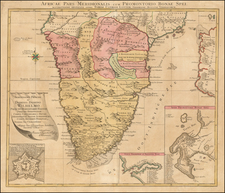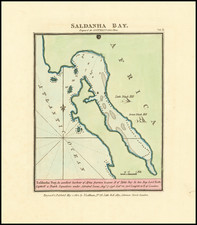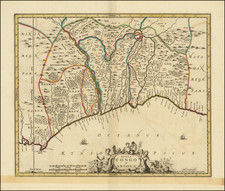Copper plate engraved image of a plantation in South Africa, from New travels into the interior parts of Africa, by the way of the Cape of Good Hope, in the years 1783, 84 and 85. . . . by Francois Valliant.
François Levaillant was a French author, explorer, naturalist, zoological collector, and noted ornithologist.
He went to the Cape of Good Hope in 1780, at the age of 27, nominally as a gunner's mate for the Dutch East India Company, but almost certainly sponsored by the Treasurer-General, Jacob Temminck with the understanding that he would strengthen Temminck's collection. At that time, South Africa was a relatively unknown and exotic location and he collected specimens that would establish his reputation within the scientific community until July 1784, when he made his way back to Holland and France. He made three journeys, one around Cape Town and Saldanha Bay (April to August 1781), one eastwards from the Cape (December 1781 to May 1783) and the third to the Orange River and into Great Namaqualand (June 1783 to c. May 1784).
During the first expedition his collection was on the vessel Middelburg, which was attacked and sunk by the English in Saldanha Bay. He did however manage to return with over 2000 specimens of birds, insects, mammals and plants. During this trip he changed his name to Le Vaillant.
An illustrative map of his travels was produced around 1790 for King Louis XVI. Measuring nine feet wide and six feet high, the map depicts the travels and the landscape met with. The cartographic elements of the map were made by Perrier with the insets of animals and landscapes by Van Leen. The birds were by Reinold. Sixty two pictures of fauna and flora were stuck onto the map. One of the animals depicted is the now extinct bluebuck.












![[Orange Free State, Transvaal, Natal and Part of the Cape Colony] Africa do Sul Folha 1 | Estado Livre d'Orange, Natal, e regiones que limitam com o Transvaal e Colonia do Cabo](https://storage.googleapis.com/raremaps/img/small/90963.jpg)
![North Africa [with] South Africa](https://storage.googleapis.com/raremaps/img/small/48322.jpg)
![[With Flags Added] The](https://storage.googleapis.com/raremaps/img/small/79510.jpg)